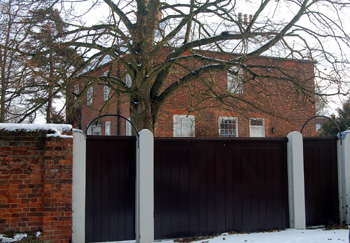Cardington Vicarages
![Elevation of the north front of the Vicarage 1792 [W3708]](/CommunityHistories/Cardington/CardingtonImages/Elevation of the north front of the Vicarage 1792 .jpg)
Elevation of the north front of the Vicarage 1792 [W3708]
The earliest reference to a vicarage at Cardington is in 1590 when "the parsonage of Cardington known as Fenlake Barns" was leased for nine years at an annual rent of £68/15/4 [FN356]. This is not the present hotel called The Barns because this property was not built until 1630 but it may have stood on the site.
In 1607 the parsonage was described in a terrier of the property of the Archdeaconry of Bedford [ABE1]. It was timber built (presumably half-timbered with plaster infill) and had a tiled roof. There were five rooms (two floored and "a little hall unfloored"). The kitchen lay in separate accommodation outside. This was a common medieval feature because the kitchen, containing a large fire, or fires, was the part of the premises most prone to be burned down and it made sense to keep this fire risk away from the main living quarters. There was also a "little house" of two bays lying outside.
The parsonage was again described in a terrier in 1708 [ABE2, page 25]. This was a timber and tiled structure and so may have been the same as the house described in 1607, though it appears to be larger, to judge by the room count, indicating that, if it was the same building, it had been added to. However, as The Barns in Fenlake was described as part of the Rectory of Cardington in 1753 [W141] it seems more likely that this house was now the Vicarage. There was a kitchen with an earth floor downstairs (perhaps added to the house because of the inconvenience of bringing food to the house through the open air) along with a parlour, a hall with a brick floor and a buttery with a partly brick, partly earth floor. Three ceiled rooms and a closet lay upstairs.
The house was not considered to be large enough by Rev. Barwell Collins, who also had the living of Great Barford and lived there in preference, as he stated in an episcopal visitation of 1720: "I do not reside here, but at Great Barford where I also officiate. The Reason of my non-residence is the want of a House, the Vicarage being too small for my Family". As late as 1782 the vicar was living at 275 Bedford Road rather than the Vicarage [P38/28/1/2]
This state of affairs was put right by Samuel Whitbread I. He was born in Cardington in 1720 and went on to found a brewery in London. This grew to become a nationwide brewing business before the company divested itself of all its breweries and licensed houses in 2002 to concentrate on hotels, restaurants and coffee shops. He was a rich man and gave many gifts to the parish and its church. He began building a new vicarage in 1781, if the date plaque on the south-east elevation is an accurate guide. Building must have taken some time as the vicar did not move in until 1783 [P38/28/1/2]. This is the house now known as Trinity House.
Trinity House was listed by the former Ministry of Works in May 1952 as Grade II, of special interest. It is built of red brick and has a hipped roof of old clay tiles. It has a double pile plan, that is two separate parts to the house lying parallel under separate roofs.
The 1925 Rating Valuation Act specified that every piece of land and every property in the country was to be assessed to determine its rateable value. Cardington, like most of Bedfordshire, was valued in 1927 and the valuer visiting the Vicarage [DV1/C116/9] found that it comprised a hall (18 feet by 17½ feet); a dining room (16 deet by 17½ feet); a drawing room (16½ feet by 10½ feet ) with a bow window; a pantry; a kitchen (18½ feet by 16½ feet); a scullery ("huge and high") with cellars under the whole house. Upstairs were a bathroom, a bedroom over the scullery for the maid, a single bedroom over the kitchen, a double bedroom over the kitchen and four more double bedrooms over hall, dining room and drawing room. Outside were two kitchen gardens and a tennis court as well as a wood barn with a loft over, stables used for storage with a loft over, a garage, a laundry, a coal barn, a wood barn and a chicken house. In the opinion of the valuer it was a "very poor place, no conveniences". It also had an adjoining grass field of 1.952 acres.
In 1965 the Vicarage became a private house and the vicar moved into a large new house built by Humphrey Whitbread in Bedford Road, facing the north-east corner of the cemetery. Since 2004 Cardington has not had a vicar, as it has formed part of the Elstow Team Ministry. The former vicarage is now Bishop's Lodge, official residence of the Bishop of Bedford.

Trinity House Christmas Eve 2010